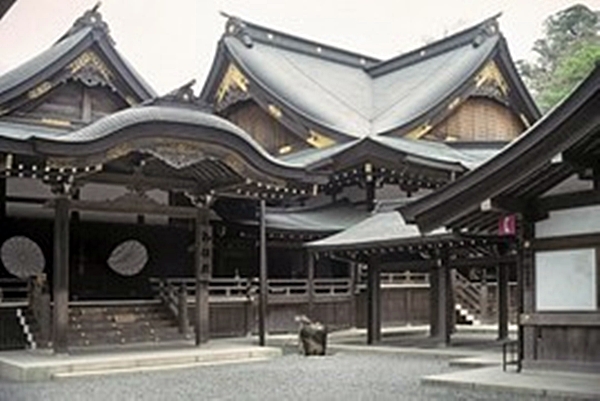Time is of the essence for Japan

My question was recently resolved during a visit to Ise Grand Shrine, located in Ise City, Mie Prefecture, about 310 kilometers (192 miles) from Tokyo.
The Japanese often say there are as many gods as grains of sand. They worship as many as eight million gods. Because the country is hit by frequent natural disasters, such as earthquakes and typhoons, they pray to various higher beings. The highest of the nature gods is the sun, and the Ise Grand Shrine is dedicated to the Sun Goddess. It is the imperial house’s shrine and the highest in the country. There is a separate rice paddy and salt field in Ise for the shrine’s exclusive use. I was amazed to see the “divine fields” where 13 kinds of rice and 70 kinds of vegetables were grown.
Ise Grand Shrine was built 1,500 years ago. But for nearly 1,400 years, no emperor visited it. According to Kogakkan University Prof. Noboru Okada, “the emperor’s dignity would be undermined if a natural disaster happened after he visited the shrine.”
Emperor Meiji, who reigned from 1868 to 1912, broke the convention. But there was a problem. The imperial house had three conditions for the emperor’s train trip to the shrine. Another train could not overtake, run side by side or run above the emperor’s train in the multilevel tracks. Today, it would take three hours via the Shikansen high-speed train and express train. But back then, the train ride took more than 10 hours. Director Junich Nishimura of the Ise City Tourism Association said, “In order to avoid any error during the long ride, thorough schedule review and training was performed, and it led to today’s minute-by-minute train and subway schedule.” The precise concept of time today goes back to Emperor Meiji’s shrine visit.
However, Emperor Meiji’s intention did not spread in Japan. When he first paid a visit to Ise Grand Shrine, he emphasized that Japan needed to look out to the world, not just at itself. Since then, the emperor could only pray for three things: world peace, abundance of food and the prosperity of the next generation. Emperor Meiji had a truly global perspective.
His vision was far from the narrow-minded perspective of Japanese political leaders and media today, who claim that past reports on the forced mobilization of “comfort women” were incorrect - as if they have ground to deny wartime sex slavery. Where did this discrepancy come from? Once my question was resolved at Ise Grand Shrine, I thought of this one. Where can I find the answer?
* The author is the Tokyo bureau chief of the JoongAng Ilbo.
BY KIM HYUN-KI
'08:05' 오늘도 어김이 없다. 출근길 도쿄 긴자(銀座)역 지하철 도착 시간이다. 지하철 플랫폼에 설치된 모니터의 '도착예정시각 08:05, 현재 시각 08:05'이란 표시를 보면서 매일 똑같은 생각을 한다. "어떻게 이렇게 매일 1분도 틀리지 않고 정확할 수 있을까. 대~단한 일본이야." (물론 지진 등 천재지변이나 자살 사고 발생 등의 경우는 예외다.) 오랜 세월 품어온 그 의문이 최근 풀렸다. 일본인의 마음의 고향이라는 '이세(伊勢)신궁'에서다. 도쿄에서 약 310km 거리의 미에(三重)현 이세시에 위치한 이세신궁. 흔히 일본에는 '모래의 수'만큼 신이 있다고 한다. 많게는 800만. 지진·태풍 등 자연재해가 많은 나라라 '모셔야' 할 신들이 많다. 그 으뜸이 태양이며, 그걸 모시고 있는 게 이세신궁이다. '황실'의 신사이자 국가 제일의 종묘다. 그래서 이세에는 최고급 이세신궁용 논과 염전이 따로 있을 정도다. '신궁신전(神宮神田)'이란 이름의 논과 밭에서 쌀 품종만 13종, 야채 종류만 70종을 재배하는 현장을 보고 경악했다. 이세신궁이 생긴 건 약 1500년 전의 일이다. 하지만 희한하게도 1400년 가까이 단 한 명의 천황도 이곳을 참배하지 않았다. "참배를 했는데 그 이후 자연재해가 발생하면 천황으로서의 체면이 깎이기 때문"(고가쿠칸대 오카다 노보루 교수) 이었다 한다. 그 고정관념을 깬 게 메이지(明治·1868~1912) 천황. 그런데 문제가 생겼다. 황실에서 천황 특별열차의 이세신궁 행에 3가지 조건을 내건 것이다. 다른 열차가 천황 열차를 추월하거나, 나란히 달리거나, 입체 선로 구간에서 천황 열차 위 선로를 지나선 안 된다는 것. 지금이야 신칸센, 특급열차를 갈아타면 3시간 거리지만 당시는 10시간 이상 걸리는 긴 여정이었다. 이세시 관광협회 니시무라 준이치(西村純一) 전무는 "긴 동선을 움직이는 동안 한치의 오차도 있어선 안 됐기 때문에 피 말리는 사전 점검과 훈련이 이뤄졌고 그것이 오늘날의 분 단위의 촘촘한 열차·지하철 시간표 작성으로 이어졌다"고 말했다. 오늘날 일본인의 '칼 같은' 시간관념은 결과적으로 메이지 천황 덕분이었던 게다. 반면 메이지 천황의 뜻이 제대로 퍼지지 못한 것도 있다. 그는 처음으로 이세신궁을 찾으면서 "이제 일본은 세계를 봐야 한다. 일본만 봐선 안 된다"고 강조했다 한다. 이후 천황은 이세신궁에서 3가지만 기원하게끔 규정돼 있다. ^세계평화 ^식량 풍족 ^자손번영이다. 가히 지구적 관점이다. 위안부 강제연행 관련 일부 과거 보도가 오보가 됐다며 위안부 전체가 부정된 듯 '그들만의 잔치'를 벌이고 있는 요즘 일본 정치 지도자나 언론의 지극히 협소한 관점과는 하늘과 땅 차이다. 왜 이런 엄청난 간극이 생겼을까. 이세신궁에서 하나의 의문이 풀리자마자 또 하나의 의문이 생기고 말았다. 어딜 가면 그 답을 얻을 수 있을까. 김현기 도쿄 총국장










with the Korea JoongAng Daily
To write comments, please log in to one of the accounts.
Standards Board Policy (0/250자)